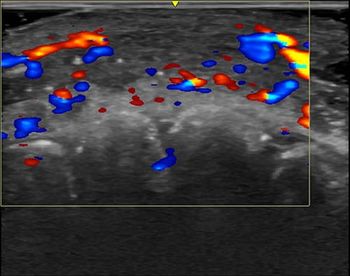
Novel CT contrast agent targets vulnerable plaque
N1177, an experimental contrast agent plucked from a foundering company, has researchers at Mount Sinai School of Medicine high on its potential for use in coronary CT angiography. The agent’s propensity to accumulate in coronary plaque rich in macrophages shows promise for identifying patients at high risk of heart attack and stroke. CT angiograms then highlight this plaque, which is especially vulnerable to rupture, putting its bearers at increased cardiovascular risk.
N1177, an experimental contrast agent plucked from a foundering company, has researchers at Mount Sinai School of Medicine high on its potential for use in coronary CT angiography. The agent's propensity to accumulate in coronary plaque rich in macrophages shows promise for identifying patients at high risk of heart attack and stroke. CT angiograms then highlight this plaque, which is especially vulnerable to rupture, putting its bearers at increased cardiovascular risk.
"N1177 allows us for the first time to look directly at the coronary arteries and pinpoint dangerous, heart attack-causing plaque," said Zahi A. Fayad, Ph.D., a professor of radiology and medicine and director of the Translational and Molecular Imaging Institute at Mount Sinai School of Medicine.
Fayad's enthusiasm is based on preclinical research conducted on rabbits using a 64-slice CT scanner. The results are scheduled for publication in the May issue of Nature Medicine. The clinical potential of the fledgling technology is buoyed by phase I clinical results establishing the safety of N1177 when administered subcutaneously.
NanoScan Imaging, a Lansdale, PA, company founded in 2005 specifically to commercialize the agent, has cultivated three forms: one applied subcutaneously to look at the spread of cancer into lymph nodes, another for inhalation to stage lung cancer, and an intravenous formulation that supports coronary CTA.
NanoScan CEO Don Skerrett said the company is focusing its energies now on developing the agent for use in CTA. The idea is to take the product as far as phase II testing, then sell or license it to one or more major pharmaceutical or diagnostic imaging companies.
"Our plan has always been to put it through its paces and get it to somebody who can really do something with it," he said.
Skerrett bought the agent a few years ago from Imcor Pharmaceuticals, which initially hoped to earn cash flow from the sale of an FDA-approved ultrasound contrast agent. The company has since failed to convert on this plan and is now foundering, trading on the over-the-counter market with virtually no volume and a share price a fraction above 2¢.
Of the three applications that might come from N1177, Skerett is partial to cardiovascular imaging, because of the expected increase in prevalence of coronary heart disease in the aging U.S. population. Skerrett predicts FDA market approval for the agent between 2010 and 2011 - optimistically, considering its current state of development - based on the less rigorous regulatory requirements for diagnostic versus therapeutic agents. About the same time, coronary heart disease will affect 14.5 million U.S. residents. That number will approach about 15.4 million in 2015, according to a forecast developed by NanoScan.
Early detection of high-risk plaques in the coronaries may provide physicians and patients the heads-up needed to begin preventive measures to ward off stroke or heart attack. Still to be determined is whether N1177 can provide that warning.
The company is working to complete preclinical testing for the IV and inhalation indications.
"Presumably, whoever will purchase or license this asset will put its own mark on some of the experimental work," Skerett said.
Negotiations are under way with several large companies, he said.
Newsletter
Stay at the forefront of radiology with the Diagnostic Imaging newsletter, delivering the latest news, clinical insights, and imaging advancements for today’s radiologists.




























